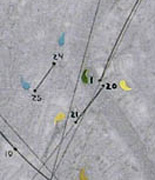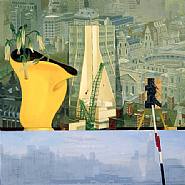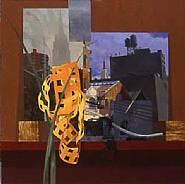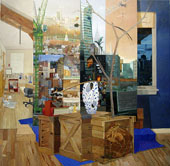[Ed. note:Artblog contributor Joe Naujokas wrote us to say he had paintings and a drawing in a three-person show at Katharina Rich-Perlow Gallery in New York. Naujokas, a 2004 PA Council on the Arts Fellow told us he was showing six new works including his first drawing in over 15 years. I thought this was most interesting and so I wrote back to Joe and asked him to expand a little. Why a drawing now, for example. Here’s what he wrote.]
Hi Roberta, thanks for the response. It must be hard for you to concentrate on art when real life drama of such proportions is affecting people you know in New Orleans. I wish for your friends the best.
*[Ed. note: Thanks, Joe. See below for more on NOLA evacuees Chuck and Iris.]
The Value of Ballpoint Drawings

I created a number of obsessively shaded drawings in the late ’80s with a ballpoint pen which I liked alot, but they did not sell at value for the time put into them, so I stopped. (Gallery Joe has done a great job of presenting drawing as worthy of full intellectual and purchasing attention). As a result of this thinking, my paintings became a struggle of composing and drawing and painting all in the final piece. I don’t do preparatory studies. I compose using Photoshop and 3-D software to plan the structure of my painting, but it’s just a start and is never even close to the final product so it is not really a study in the traditional sense. Recently I have been drawing less in the paintings and painting more, so maybe I had a need to draw something. (image above and below are “bubble chamber,” details)
Global Positioning and Where Are We Anyway?
Many people first approach my work with the obvious question “where was it painted?” which is fair enough because I am a documentarian painter — I paint what is there.

The drawing started as a practical way to show exactly where the paintings are about, then evolved into an “after-study” of the paintings in the show. I used GPS coordinates and Google’s satellite mapping search engine to create weblinks to where I was standing and what I was looking at when painting the paintings in this show. See website for more. I aligned maps from three general locations (New York, London, Philadelphia) along one shared sight line, and then looked at how the other sight lines became organized.
Lining up with Ground Zero

For instance, the sight line from where I was standing on the Millennium Bridge looking towards St. Paul’s in London pointed directly at Ground Zero in New York on the sightline map (from where I painted the longest sightline — towards the Verazzano Bridge- before 9/11). This at first struck me as poetically very interesting, but also smacks a little of those “golden rule” drawing overlays of old master paintings from the 70’s / 80’s (which I confess to have heavily indulged in while at Cleveland Institute of Art).
(image above is “London/NY Yellow,” 2005)

Interestingly enough, some straight lines of sight in the paintings translated into curved lines on the map. Another interesting thing is that when clicking on the GPS links, a visual line-of-sight is inferred and driving directions (governed by rules of one-way streets and geography) are drawn out in circuitous blue lines, reminding me of Paul Klee‘s quote “Drawing is taking a [sight]line for a walk.” This mapping connects with what Mathew Barney and David Lynch are trying to do in regards to physically connecting physically separated locations.
(image above is Chelsea Empire Two, 2004)

This drawing also relates to “Bubble Chamber experiments” and my ongoing fascination with the quantum mechanics of how and what the world is made up of. I am very much interested in how a mapping of the earth and where I have been and what I have been looking at is similar to the the mappings of the escape trajectories of teeny tiny invisible sub-atomic particles.
(image is “Empire Manhattan, Philadelphia, Snoqualmie Falls, Miami Beach,” 2004)
The paintings are not meant to be illustrations of these ideas. The after-study drawing is the intellectual illustration that frees-up the paintings to be experienced in a more emotional manner, in context.
You can see the drawing at my website (though without legible detail). –Joe
Katerina Rich-Perlow Gallery, The Fuller Building, 41 E. 57th Street, 212-644-7171
September 8 October 6 2005
“Three-Dimensional New York”
*[Ed. note: Quick Chuck and Iris update: They have moved up to the Bronx where Iris was offered a lab space along with subsidized housing at Albert Einstein Medical Center. Iris made a trip to her New Orleans lab at LSU Medical Center two weeks ago along with some other LSU researchers and retrieved her computer hard drives. But her 20 plus years of tissue samples and antibodies and plasmids are lost for having sat un-refrigerated for weeks. Chuck will go down to New Orleans next week to check in with his museum, the HNOC. They are coping, all things considered, although living in the moment since the future is still unclear. To track back, read here, here and here]









